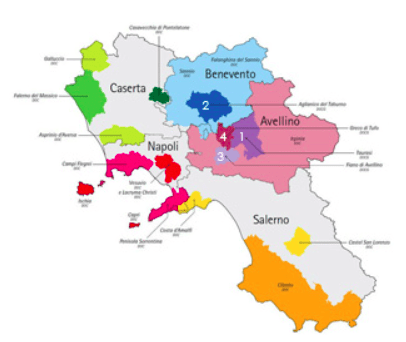xtraWinexperience goes to Campania
Playground of the Romans during the heydays of the Roman Empire, Campania has a fascinating history and even more fascinatingly interesting wines.
The region was colonised (a colonia) by the Greeks and the Etruscans and it was dominated for centuries by the city of Capua, founded in the 6th century BC. Naples, founded in the 7th century BC by the Greeks (Naples is nothing but Nea polis or new city) was a less powerful city, which later flourished under the Romans with its iconic port.
The term ‘Campania’ was first used in the 5th century BC by the Samnites,which conquered Campania around that time.
Capua – which was the fortress of the Samnites’ power, became Rome’s ally in the early 4th century BC and by the end of that very same century, Capua was fully Romanised.
During the Roman Empire, Campania’s territories expanded and the region as a whole flourished. Deemed the playground of the elite of the Empire, it became an important centre with cities like Nola, Cumae and Puteoli. Naples was the only city to remain somehow immune to the cultural Romanisation, remaining the only place in the Empire to use Greek as the official language and maintain Hellenic mores.
After the fall of Rome and the end of the Roman Empire, Campania was occupied by multiple tribes, making it a meltin pot of cultures and civilisations. The region, in fact, was occupied by Goths, Byzantines, and Lombards. It was then conquered by the Normans in the 11th century and it was incorporated in the kingdom of Sicily in the 12th century. During the Middle Ages Campania was stage to multiple power struggles. It became part of the Kingdom of Naples after the Wars of Sicilian Vespers against the French in 1282. After all these adventures, Campania was united with Italy in 1860.
Campania and its wines
Tangible evidence of the culture of the region and its cultural links with the past is the form of cultivation of Etruscan origin, the suggestive Alberata. Still used for the cultivation of Asprinio di Aversa, in the North of Campania, it allows a very expansive growth in height with great productivity. The vine, a unique case in the world with the exception of a few areas in the North of Portugal, climbs the trees to incredible heights, turning the grape harvest into an acrobatic test, with ladders of over 20 metres.
The Aversana Alberata and the method of cultivation of the vine married to the poplar have officially become “Intangible Cultural Heritage of Campania“ by UNESCO along with Pizza.
In the South of the region, the Greek low bush system is more widely used, with vigorous pruning and rather low productivity. In addition to Asprinio, other more cultivated vines have ancient origins, such as Aglianico, derived from the Hellenic vine introduced by the Greeks, from which one of the most structured and long-lived wines of the entire national production is obtained, Taurasi, the only red DOCG in the region.
Two white grape varieties also have ancient origins, the Greek coming from Thessaly and Fiano, probably with even more remote roots linked to the Phoenicians. Today, both Fiano di Avellino and Greco di Tufo are DOCG.
Other indigenous white grape varieties are biancolella, forastera, coda di volpe and falanghina, while red grape varieties include sciascinoso, casavecchia and piedirosso or per’ e palummo or piede di colombo, whose curious name derives from the shape of the racimolo, which resembles the pigeon’s foot.
Also in this region, there is no lack of grape varieties from other Italian or foreign regions, such as Sangiovese, Aglianico, Cabernet Sauvignon and Barbera.

xtraWinexperience Campania with Feudi Di San Gregorio
One of the most iconic and internationally renowned wine makers of Campania are Feudi di San Gregorio.
Founded in 1986, the winery is built 50 km from the Vesuvius or the city of Pompeii, located in the hinterland and an hour by motorway from Naples.
The building that houses Feudi di San Gregorio propels the two thousand year-old wine-making tradition of Irpinia into the future.
Over the years, Feudi di San Gregorio added other vineyards in the municipalities of Tufo, Taurasi and Santa Paolina, the 30 hectares of vineyards in Sorbo Serpico, hence bringing the total to 300 hectares that enjoy the benefits of a land known for its vines characterised by volcanic soil and significant temperature swings between day and night,.
The winery produces Greco di Tufo, Taurasi, Falanghina, as well as Fiano and Rubrato.
These jewels testify to Feudi’s long-standing commitment to recovering and protecting native vines and tradition in its homeland as well as in the new vineyards of Vulture and Manduria.
However, another, and even more fascinating aspect of our xtraWinexperience in Campania with Feudi di San Gregorio is the winery’s attention to tradition and technology, architecture and hospitality.
Feudi Di San Gregorio is not only the most representative winery of the South of Italy; it is a cultural laboratory. The winery, in fact, has been entirely designed by the Japanese architect Hikaru Mori and it has been exhibited twice as an architectural excellence at the Biennale di Venezia.
The building expands mainly underground, without any environmental impact and it was built with the idea to convey the winery’s ambition to become a place for encounters and discussions, a laboratory for ideas and culture.
Stay tuned and discover Campania with xtraWine.

Interviste esclusive dal mondo del vino ed approfondimenti da chi fa del vino una ragione di vita, di business e di cultura.










